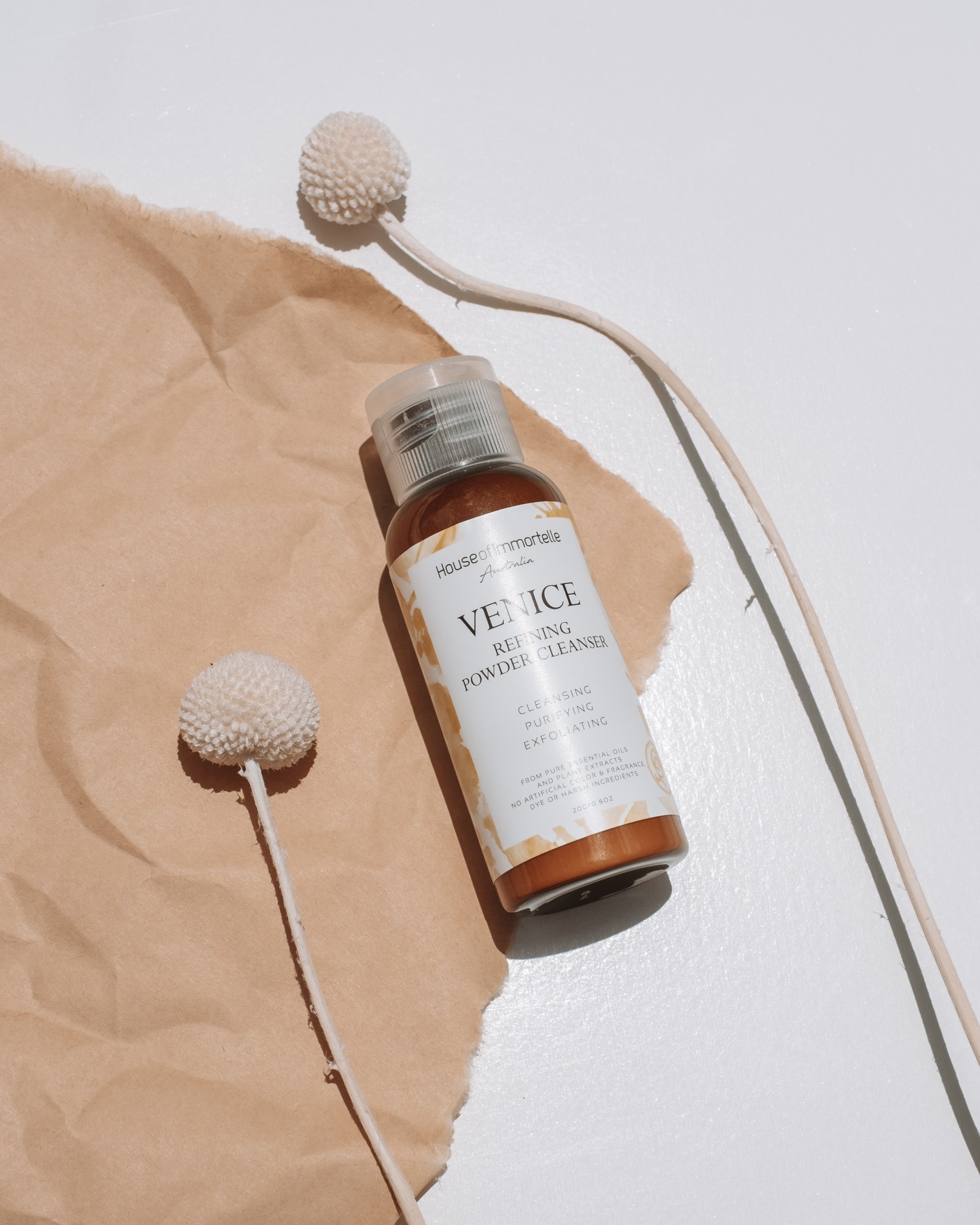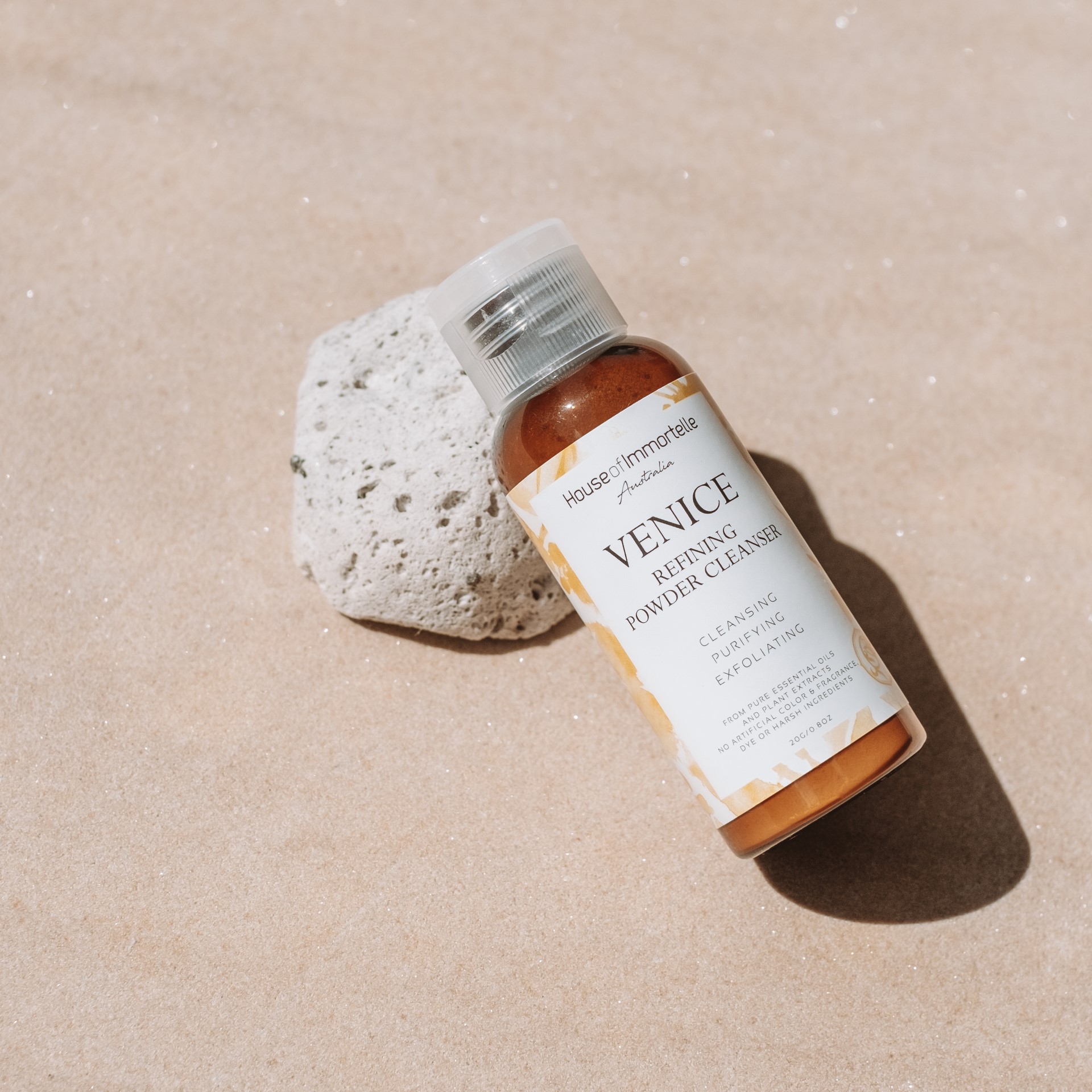
We all know exfoliating is great for our skin; through the removal of dead skin cells, you leave your skin not only softer and smoother but also as a blank canvas to absorb all the goodness from your House of Immortelle products. But before diving into an exfoliation routine, it’s crucial to understand your skin type. In this article, we’re going to give you a guide on realising what your own skin type is, so that you know the best course of action to get the results you’re looking for from your exfoliation routine.
Different Methods of Exfoliation
Before exfoliation, you’ll want to begin with a natural face cleanser to achieve optimal results. Then, you can move on to deciding which exfoliation method is best for you, either mechanical exfoliation – where you physically scrub the skin with tools or products with a grainy texture, such as a refining powder, which removes dead skin cells for a smoother texture. Or chemical exfoliation, which involves the use of chemicals to dissolve dead skin cells. Alpha hydroxy acids (AHAs) and beta hydroxy acids (BHAs) are commonly used in chemical exfoliants.
The Skin Types
Whichever method of exfoliation you choose will be defined, largely, by your skin type. So, let’s break down the various skin types so that you can figure out your own and decide the best method for optimal skincare:
- Normal Skin
Normal skin is well-balanced, neither too oily nor too dry. It tends to have a smooth texture, small pores, and a relatively healthy complexion. If you have normal skin, you have the flexibility to choose between mechanical and chemical exfoliation methods. Starting with a cloth or sponge and a mild chemical exfoliant is a great option.
- Dry Skin
Dry skin often feels tight, rough, and flaky. It lacks moisture and may be prone to sensitivity. For individuals with dry skin, mechanical exfoliation methods may be too harsh and irritating. Instead, opt for a gentle washcloth and a mild chemical exfoliator. It’s crucial to follow exfoliation with a hydrating moisturiser to replenish the skin’s moisture barrier.
- Oily Skin
Oily skin is characterised by excess sebum production, making the skin appear shiny and prone to breakouts. Mechanical exfoliation using a scrub or a brush can be an effective method for oily skin, as it helps to unclog pores and remove excess oil.
- Sensitive Skin
Sensitive skin is easily irritated and may react negatively to certain skincare products or environmental factors. It’s essential to approach exfoliation with caution if you have sensitive skin. Avoid harsh physical exfoliants and opt for gentler methods. The House of Immortelle refining powder is an ideal product for sensitive skin types.
- Combination Skin
Combination skin is a mix of different skin types, with some areas being oily and others dry or normal. If you have combination skin, it’s important to tailor your exfoliation routine to address the specific needs of each area. You can opt for a combination of mechanical and chemical exfoliation methods, using a brush or scrub on oily areas and a mild chemical exfoliant on dry or sensitive areas.

How Often Should You Exfoliate for Your Skin Type?
The frequency of exfoliation depends on your skin type and the exfoliation method you choose. It’s important to strike a balance between reaping the benefits of exfoliation and not overdoing it. Here are some general guidelines for how often you should exfoliate based on your skin type.
If you have normal skin, exfoliating once a week is generally sufficient. However, if you feel that your skin can handle a more intense exfoliation, you can increase the frequency to once every few weeks. Pay attention to any signs of irritation or sensitivity and adjust your exfoliation routine accordingly.
For individuals with dry skin, it’s important to be cautious when exfoliating. Once a week is typically a safe frequency to avoid stripping away too much moisture. However, if you notice any signs of dryness or irritation, reduce the frequency to once every two weeks.
Oily skin can tolerate more frequent exfoliation due to the excess sebum production. Exfoliating two to three times a week can help control oiliness and prevent clogged pores. If you notice any irritation, drop it down accordingly.
If you have sensitive skin, it’s crucial to approach exfoliation with caution. Start with a minimal frequency of once every two weeks and observe how your skin reacts.
If you have combination skin, you will require a tailored approach to exfoliation. Focus on treating each area of your face according to its specific needs. Exfoliate the oily areas two to three times a week and the dry or sensitive areas once a week or as needed.
Now that you’ve discovered your own skin type and have a basic guide on how to incorporate exfoliation into your regular skincare regimen, you can begin shedding those dead skin cells and reveal your glowing skin. Remember to proceed with caution, though; take things slowly, to begin with whilst you get to know your skin better. Just like anything else, your skin will let you know if what you’re doing is working and when you’re treating your skin to the best products that House of Immortelle can offer, your skin is bound to reap the rewards.